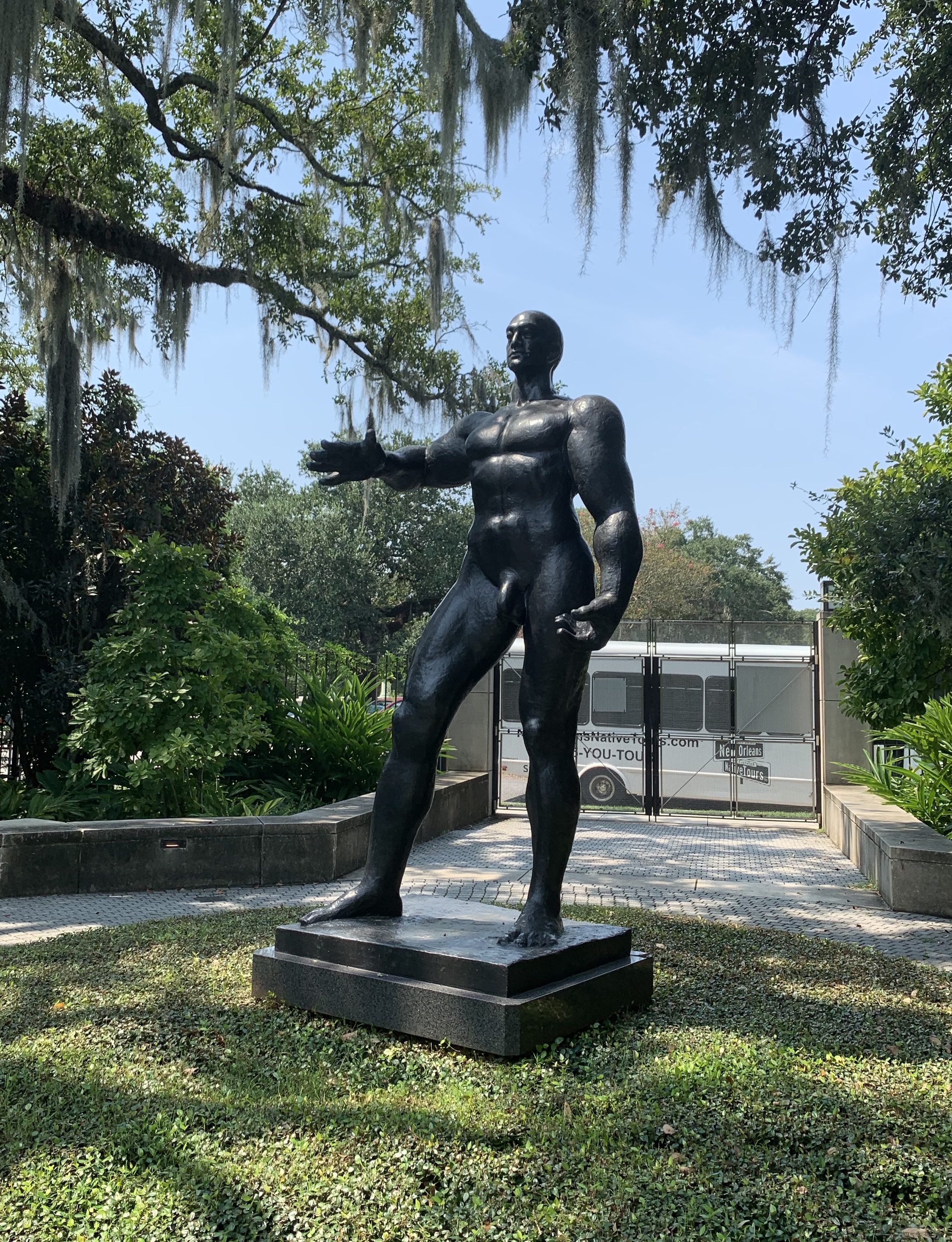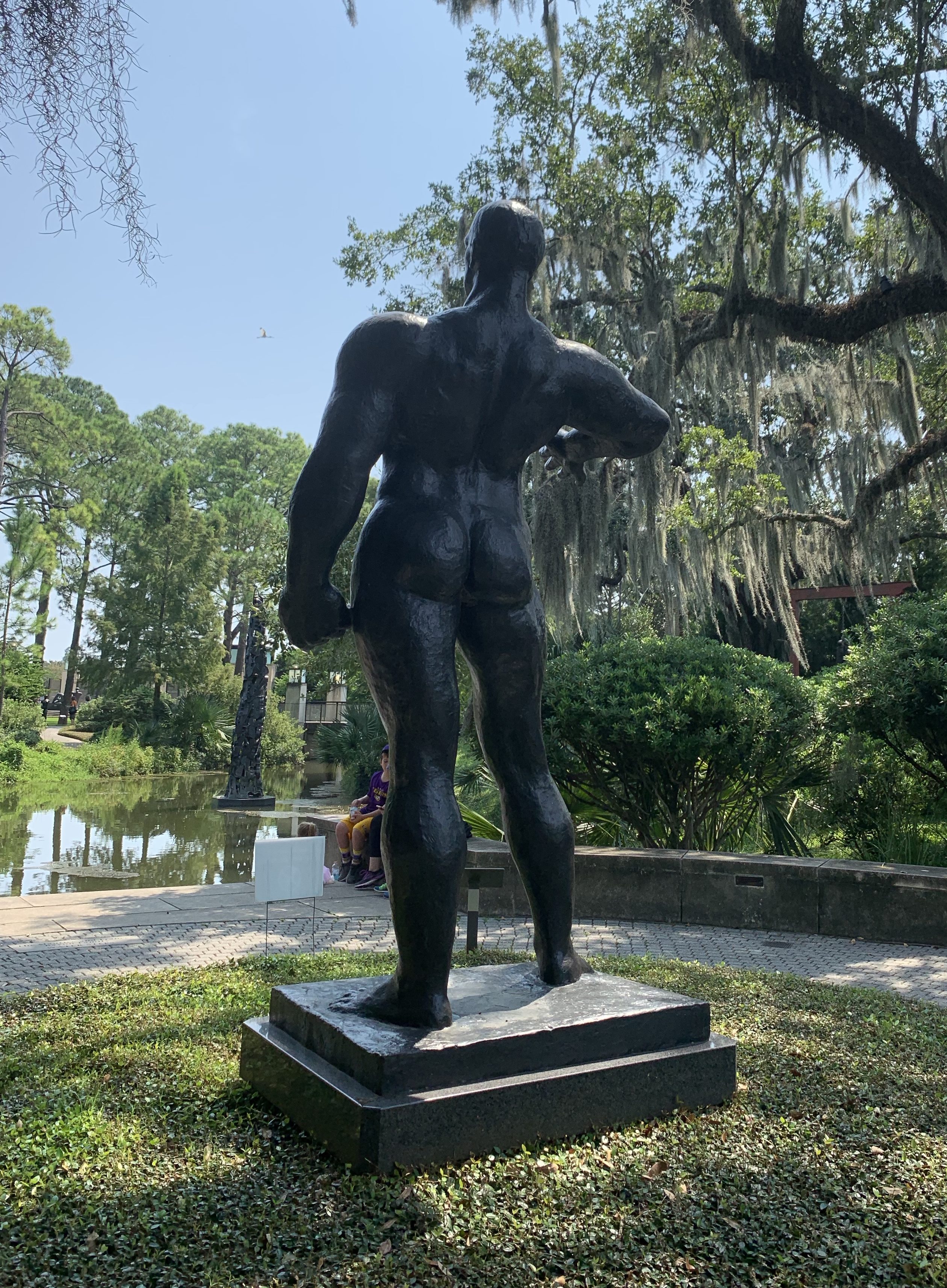Heroism is a tale as old as the written word according to Franco et al article Heroism Research: A Review of Theories, Methods, Challenges, and Trends (2). Ritchie Gibson of The Daily Telegraph explains that heroes are ordinary people with extraordinary actions. Gibson refers to his fellow soldiers from his days in the military and those who have selflessly supported him as examples for heroes. The people that Gibson choose as his hero can arguably be the archetype of persons that most Americans choose to encapsulate heroism. A commonality between all examples of a hero is the tendency to define hero with actions, though Franco et al recognize that a consistent definition of hero is near impossible. In most contexts, someone must do something to be heroic, selfless, world-changing to be a hero (2).
The “Hero” in the New Orleans Museum of Art’s public sculpture garden reaches over eight feet tall and faces gallantly South, looking over the pond that winds through City Park in New Orleans. The Heroic Man towers over everything around him with his back straight, chest out, and chin up; a position which some research suggests increases testosterone and other “risk-taking” hormones. Waymarking.com calls the sculpture by Gaston Lachaise, “proud and triumphant, like a winning athlete or warrior.”

Heroic Man bronze sculpture by Gaston Lachaise in the New Orleans sculpture garden
His hands are as big as his watermelon sized head. The forearms seem to be made of two long, overinflated balloons. He is nude, and his testicles are visible. His muscles are cut, abdominals prominent. His legs are almost one and a half times the length of the rest of his body. The statue’s exaggerated limbs are reminiscent of Mannerism that utilized the exaggeration of limbs and proportions to suggest movement and heightened drama. Proportion is also important because we use ourselves as a reference point, and we tend to marvel at things that are significantly smaller or larger than ourselves. Spectators are expected to be in awe of The Heroic Man. We are to look at his strange proportions and be intimidated by his size. According to Franco et al, this reverence is what, through history, has made a figure a hero (2). Problematically, boys and men feel as though they need to be noticed and heroic based on gender roles. If a man is not awed at, if he is not seen, he cannot be the hero that he is expected to be. These expectations are noticed in Boys’ Perceptions of the Male Role: Understanding Gender Role Conflict in Adolescent Males, when boys reported that they felt “societal pressure to … to succeed and show dominance in class, in groups, and in athletics” (4).
Throughout history, gender roles have affected how the population acts. It varies from culture to culture but, overall, women’s roles based on their gender have changed substantially. Dating back to the Viking Age, men were buried with swords and weapons; women were buried with household items, needlework and jewelry. Today though, women are beginning to see changes in their roles. The artist of Heroic Man, Lachaise, spent the majority of his career creating art of women; yet, he now has this sculpture of a man. Lachaise is forming his idea of what makes a man or woman with his statues, and his ideas of the genders align with classic gender identity roles.
With the many figures of femininity that Lachaise has made such as Sitting Woman, Standing Woman, or Elevation (Standing Woman), the females have been named after what they were doing in that form. We know that Lachaise’s women are women because the title says so. We know that Lachaise’s Heroic Man is a man not only because of the title, but because of the physical aspects attributed to him. Obviously, Heroic Man’s penis is visible, the first indicator of his sex, and we can address the secondary sexual characteristics of the statue such as a lack of breasts. Spectators can also feel the masculinity of Heroic Man through his physical attributes. Gender roles have been expressed through art since the beginning of art itself. Male gender representations are often seen by “notions of power and weakness, superiority and inferiority, benevolence and malevolence.” The use of The Heroic Man’s size, muscles, and stature together paint the gender roles that are placed upon men in today’s society because those exact characteristics are used to define the power and superiority of Heroic Man.
Men already feel that they are expected to be the “breadwinners.” Men are supposed to be strong and the “logical” partner. These social pressures have led to a culture of toxic masculinity. This culture has constantly been pointing to men as the problem, but we have not looked at the culture that makes men feel that they have to be emotionless, unaffectionate, and dominant. Even on Facebook, a viral post wrote:
“The HUSBAND is to pay the MORTGAGE, BIGGER household bills and the WIFE should make sure the

Heroic Man bronze sculpture by Gaston Lachaise in the New Orleans sculpture garden
Home and CHILDREN are WELL attended AND kept IN TACT. All of these NEW SCHOOL rules of “WE’RE 50/50” and “SPLITTING BILLS” is complete NONSENSE. No REAL man is going to have you Splitting bills! How can a man be the HEAD of his house when he’s not the one LEADING? And the ONLY men who would complain about this are the ones who are NOT financially stable. Should your “HUSBAND” fall on hard times, a wife should be able and willing to pick up the pieces but if he’s the HEAD, he needs to be the COMPLETE HEAD! #LETSARGUE #ISaidWhatISaid.”
The Facebook post puts an emphasis on “real men” and their roles in society. The Heroic Man encapsulates the same idea with the image he gives of a hero. The post along with the visionary aspects of The Heroic Man paints the ideal of the gender roles afflicted onto males. The feelings of pressure to not only be the hero of your family and society as the post suggests, but the pressures of also looking like a hero. Take the Heroic Man and his stature for example. Rachel Anderson did a study on the perception of height and gender roles and summarized how height has been integrated into how powerful or dominant a person may be in accordance with their gender. Anderson’s research found that shorter men were seen as more feminine (1). The idea goes back to toxic idea that anything feminine is bad, so if shortness is seen as feminine, it is bad. Of course, then, The Heroic Man had to be over eight feet tall. He could not be heroic otherwise.
Heroic Man can arguably represent the pressures that so many men and boys feel they face today which have led to toxic masculinity. The Heroic Man statue appears to be a bodybuilder. According to Jackson Katz’s chapter Advertisement and the Construction of Violent White Masculinity, the media that is so often targeted at men have a large, muscular, violent hero as the main character. Katz wrote, “For many males who were experiencing unsettling changes, one area of masculine power remained attainable: physical size and strength and the ability to use violence successfully” (3). Men could assume that The Heroic Man is heroic because of some violent act in which someone or something was defended using physical force. The idea of destruction and pain is then further fed into the male rhetoric of strength and heroism.
As beautiful as Gaston Lachaise’s Heroic Man may be, its physical attributes unfortunately perpetuate an ideal about men that has led western culture into toxic masculinity. A relationship to manliness, heroism, strength and violence continues to be forced onto boys and men. The stereotypes and expectations of the male gender are continuing to be moved through our culture through all forms of media and art including sculptures like Heroic Man. It is time that society start allowing men to unapologetically be themselves without a constant reminder of what history has made them out to be.
 NOLAbeings Multimedia artist Claire Bangser created NOLAbeings as a portrait-based story project that marries...
NOLAbeings Multimedia artist Claire Bangser created NOLAbeings as a portrait-based story project that marries...  Voodoo in New Orleans: Reviving history: New Orleans fortune telling This article takes a deep dive into the history of Voodoo in New Orleans, its hybridization with Catholicism, and its present-day place in the city's culture. The author visits fortune-tellers in the French Quarter, using their guidance as a tool for introspection rather than a deterministic predictor of the future. Through her experiences in New Orleans, the author feels a mystical connection to both the past and the future.
Voodoo in New Orleans: Reviving history: New Orleans fortune telling This article takes a deep dive into the history of Voodoo in New Orleans, its hybridization with Catholicism, and its present-day place in the city's culture. The author visits fortune-tellers in the French Quarter, using their guidance as a tool for introspection rather than a deterministic predictor of the future. Through her experiences in New Orleans, the author feels a mystical connection to both the past and the future. 